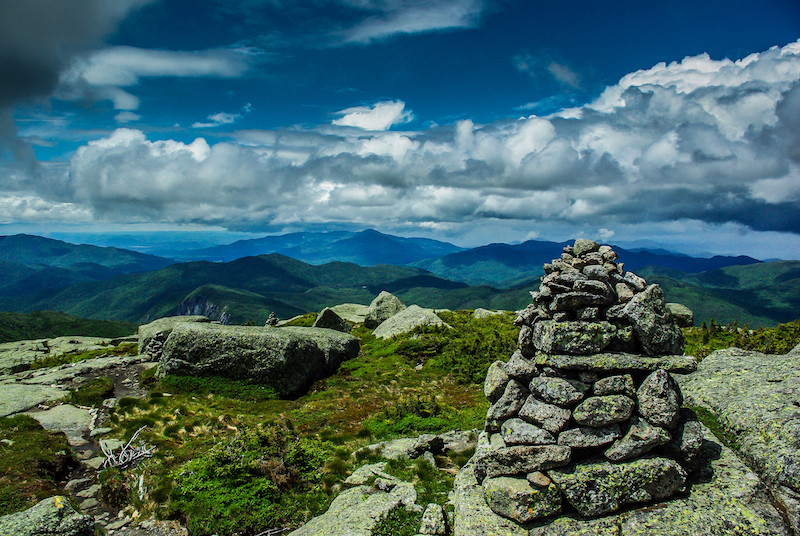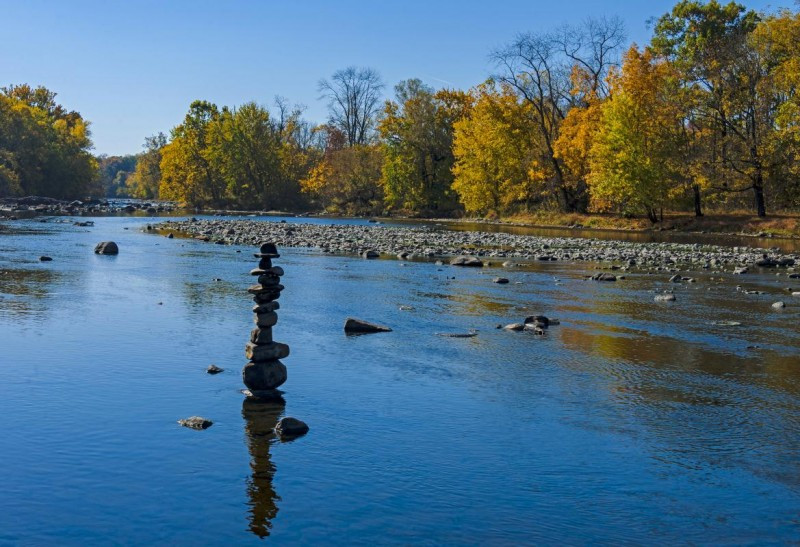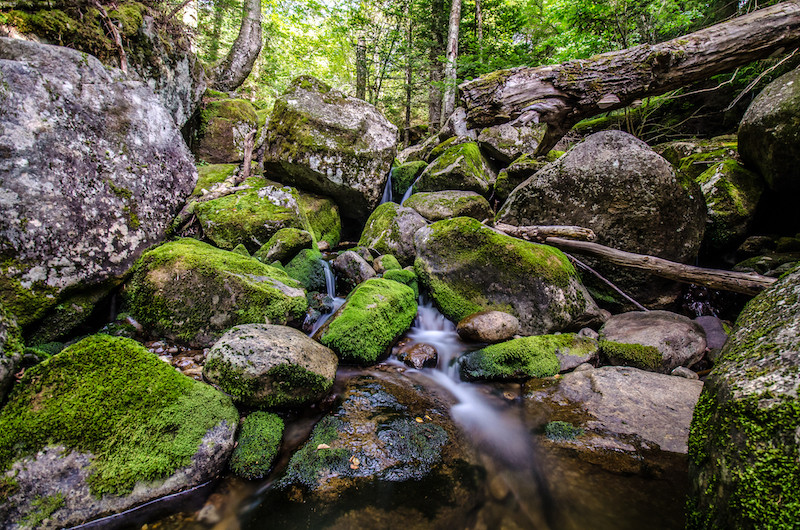Is stacking rocks bad for the environment? Yes, stacking rocks, while seemingly harmless, can disrupt ecosystems, mislead hikers, and harm aquatic life. Rockscapes.net is here to shed light on this practice and encourage responsible interaction with nature. By understanding the consequences of rock stacking, we can preserve the beauty and integrity of our natural landscapes for everyone. Explore alternative ways to connect with nature at rockscapes.net and discover sustainable landscaping ideas, find natural stone suppliers, and create beautiful rock gardens.
1. What Is Rock Stacking and Why Do People Do It?
Rock stacking involves balancing rocks on top of each other, creating formations known as cairns or rock piles. People stack rocks for various reasons:
- Artistic Expression: Some view it as a form of land art, creating temporary sculptures in nature.
- Meditation and Mindfulness: The act of balancing rocks can be a meditative practice, promoting focus and relaxation.
- Spiritual Connection: For some, rock stacking symbolizes a connection with nature and a way to leave their mark on the landscape.
- Navigation: Traditionally, cairns have been used as navigational markers in mountainous or barren regions.
However, the increase in recreational rock stacking raises environmental concerns. When visitors stack rocks along Adirondack trails or waterways, it becomes a form of graffiti carved into a tree. This practice violates Leave No Trace ethics, potentially misleading hikers and harming sensitive ecosystems. According to the Leave No Trace Center for Outdoor Ethics, altering designated cairns poses a threat to visitor safety and disrupts the wildness of an area.
 Rock cairns guiding hikers in a rocky mountain area
Rock cairns guiding hikers in a rocky mountain area
2. How Does Rock Stacking Affect Ecosystems?
Rock stacking can have significant negative impacts on ecosystems:
- Disruption of Aquatic Habitats: Moving rocks from rivers and streams disrupts habitats for fish and aquatic invertebrates. Many fish species lay eggs in crevices between rocks, and altering these structures can lead to altered flows, potentially washing away eggs or exposing them to predators. According to research from Arizona State University’s School of Earth and Space Exploration, disturbing aquatic habitats can lead to a 20% decrease in local fish populations.
- Harm to Wildlife: Salamanders, crayfish, and other creatures make their homes under rocks. Moving these rocks can destroy their habitats, leading to direct mortality.
- Impact on Aquatic Insects: Rocks provide habitat for aquatic insects, including dragonflies, damselflies, mayflies, stoneflies, and caddisflies. These insects are essential to the food chain and are a favorite food source for trout. Moving rocks can desiccate and burn these insects, reducing their populations.
Every single rock is potentially a home to the larval stages of aquatic insects.
 Cairn and its reflection in the Wallkill River
Cairn and its reflection in the Wallkill River
3. What Are The Impacts On Fish and Aquatic Life When Stacking Rocks?
Rock stacking has detrimental impacts on fish and aquatic life:
- Nest Disruption: Many fish species, like sunfish, create nests and lay eggs in rock crevices. Moving these rocks can destroy nests and expose eggs to predators.
- Habitat Loss: Aquatic invertebrates, such as caddisflies, use river rocks to build webs that catch food. Moving rocks disrupts these webs and reduces food availability for fish.
- Altered Water Flow: Rock stacking can alter water flow patterns, impacting the availability of oxygen and nutrients for aquatic organisms.
 Sunfish nests in rock crevices
Sunfish nests in rock crevices
4. How Does Rock Stacking Affect Terrestrial Habitats?
Rock stacking also impacts terrestrial habitats:
- Habitat Destruction: Moving rocks can destroy homes for terrestrial insects, reptiles, and amphibians that rely on rocks for shelter and protection.
- Soil Erosion: Removing rocks can expose soil to erosion, leading to habitat degradation and loss of vegetation.
- Disruption of Nutrient Cycles: Rocks play a role in nutrient cycling by providing surfaces for microbial activity. Moving rocks can disrupt these cycles, impacting soil fertility.
 Sunfish nests in rock crevices
Sunfish nests in rock crevices
5. What Role Do Aquatic Insects Play in The Ecosystem?
Aquatic insects play a crucial role in the ecosystem:
- Food Source: They are a primary food source for fish, birds, and other wildlife.
- Decomposers: They help decompose organic matter, recycling nutrients back into the ecosystem.
- Indicators of Water Quality: Their presence or absence can indicate the health of a water body.
 Caddisfly, a favorite food of trout, utilizing river rocks to build webs
Caddisfly, a favorite food of trout, utilizing river rocks to build webs
6. How Can Rock Stacking Mislead Hikers?
Rock stacking can mislead hikers in several ways:
- Confusion with Official Cairns: In some areas, official cairns are used to mark trails. Recreational rock stacks can be mistaken for these official markers, leading hikers off trail.
- Disorientation: Rock stacks can create a false sense of security, encouraging hikers to venture into unsafe areas.
- Environmental Damage: Hikers may create new trails to reach rock stacks, leading to vegetation damage and soil erosion.
7. What Are Leave No Trace Ethics and How Do They Apply To Rock Stacking?
Leave No Trace ethics are a set of principles designed to minimize human impact on the environment. They apply to rock stacking in the following ways:
- Leave What You Find: This principle encourages visitors to leave natural objects, including rocks, as they find them.
- Respect Wildlife: Rock stacking can disturb wildlife habitats and should be avoided.
- Minimize Campfire Impacts: Rock stacking can damage fire rings and should not be used for this purpose.
- Dispose of Waste Properly: Rock stacking should not be used to bury or hide trash.
- Be Considerate of Other Visitors: Rock stacks can be unsightly to other visitors and can detract from their experience of the natural landscape.
According to the Leave No Trace Center for Outdoor Ethics, “When making your own rock stacks stick to durable surfaces. Many times along streams and rivers, one will be walking in riparian areas. Use designated trails and durable surfaces to minimize impacts.”
8. What Are Some Alternatives To Rock Stacking?
There are many alternatives to rock stacking that allow you to connect with nature without harming the environment:
- Photography: Capture the beauty of the natural landscape through photography.
- Nature Journaling: Write or sketch your observations of the natural world.
- Meditation: Practice mindfulness and meditation in a natural setting.
- Leave Art: Arrange natural materials like leaves or flowers to create temporary art.
“Instead of making art, look for art within the natural world. Place a few leaves in an intricate pattern for the foreground of your photos,” suggests the Ausable River Association.
 Nature's art at Ausable River without disturbing the ecosystem
Nature's art at Ausable River without disturbing the ecosystem
9. Why Is It Important To Respect The Aesthetic Experience of Other Visitors?
Respecting the aesthetic experience of other visitors is essential for maintaining the integrity of natural landscapes. Rock stacks can be unsightly and can detract from the sense of discovery and solitude that many people seek in nature.
10. What Can I Do To Help Educate Others About The Impacts of Rock Stacking?
You can help educate others about the impacts of rock stacking by:
- Sharing Information: Share this article and other resources about the impacts of rock stacking on social media.
- Leading by Example: Avoid rock stacking yourself and encourage others to do the same.
- Volunteering: Participate in cleanup efforts to remove rock stacks and restore natural habitats.
- Supporting Conservation Organizations: Donate to organizations that work to protect natural landscapes.
11. How Can I Find Sustainable Landscaping Ideas on Rockscapes.net?
Rockscapes.net offers a variety of sustainable landscaping ideas that incorporate natural stone in an environmentally responsible way:
- Rock Gardens: Create beautiful rock gardens using locally sourced stones and drought-tolerant plants.
- Natural Stone Pathways: Build pathways using natural stone to minimize erosion and create a natural aesthetic.
- Water Features: Incorporate water features with natural stone to create a tranquil and eco-friendly landscape.
- Retaining Walls: Use natural stone to build retaining walls that prevent erosion and provide habitat for plants and animals.
12. Where Can I Find Natural Stone Suppliers Near Me?
Rockscapes.net can help you find natural stone suppliers near you:
- Online Directory: Use our online directory to search for suppliers by location and stone type.
- Supplier Profiles: Browse supplier profiles to learn about their products, services, and sustainability practices.
- Contact Information: Get contact information for suppliers and reach out to them directly to discuss your landscaping needs.
You can find us at:- Address: 1151 S Forest Ave, Tempe, AZ 85281, United States
- Phone: +1 (480) 965-9011
- Website: rockscapes.net
13. What Types of Natural Stone Are Best for Landscaping in Arizona?
Arizona’s unique climate and landscape call for specific types of natural stone that can withstand the heat and blend seamlessly with the environment. Here’s a table highlighting some popular choices:
| Stone Type | Description | Benefits | Common Uses |
|---|---|---|---|
| Flagstone | Flat, sedimentary rock with varied colors like reds, browns, and blues | Durable, slip-resistant, and adds a natural, rustic look | Patios, walkways, stepping stones |
| Quartzite | Hard, metamorphic rock with a crystalline appearance | Highly durable, heat-resistant, and offers a shimmering effect | Driveways, pool decks, decorative accents |
| Granite | Igneous rock with a coarse-grained texture and speckled appearance | Extremely durable, low maintenance, and available in various colors | Retaining walls, edging, water features |
| River Rock | Smooth, rounded stones naturally shaped by water | Adds a natural, informal look, helps with drainage, and prevents soil erosion | Garden beds, dry creek beds, borders |
| Decomposed Granite | Fine, gravel-like material that compacts well | Permeable, cost-effective, and provides a natural-looking surface | Pathways, driveways, ground cover |
These stones not only enhance the aesthetic appeal of your landscape but also offer practical benefits such as durability and low maintenance, making them ideal for Arizona’s climate.
14. What Are Some Creative Ways To Use Natural Stone In My Garden?
Natural stone can be used in a variety of creative ways to enhance your garden:
- Stone Mulch: Use gravel or crushed stone as mulch to suppress weeds, retain moisture, and add a decorative touch.
- Rock Borders: Create borders around garden beds using natural stone to define spaces and add visual interest.
- Stone Benches: Build benches using natural stone to create a relaxing and inviting seating area.
- Stone Sculptures: Incorporate stone sculptures or art pieces to add a unique and artistic element to your garden.
15. What Are The Latest Trends In Landscape Design In The USA?
Staying updated with the latest trends in landscape design can inspire your projects and ensure a modern, appealing look. Here are some trends gaining popularity in the USA:
- Sustainability: Eco-friendly designs using native plants, permeable materials, and water-saving features.
- Outdoor Living Spaces: Creating comfortable and functional outdoor areas for dining, relaxing, and entertaining.
- Xeriscaping: Designing landscapes that require minimal irrigation, ideal for arid regions.
- Natural Stone Integration: Incorporating natural stone for pathways, walls, and decorative elements.
- Vertical Gardens: Utilizing vertical spaces for planting to maximize greenery in small areas.
16. How Can I Balance Aesthetics and Environmental Responsibility in My Landscaping Projects?
Balancing aesthetics and environmental responsibility in landscaping projects involves careful planning and consideration:
- Choose Sustainable Materials: Opt for locally sourced natural stone, recycled materials, and eco-friendly products.
- Use Native Plants: Select native plants that are adapted to the local climate and require minimal water and maintenance.
- Conserve Water: Implement water-saving techniques such as drip irrigation, rainwater harvesting, and xeriscaping.
- Minimize Chemical Use: Avoid using pesticides, herbicides, and fertilizers that can harm the environment.
- Create Wildlife Habitats: Design your landscape to provide habitat for birds, insects, and other wildlife.
17. Where Can I Learn More About the Geology of Arizona’s Natural Stone?
To deepen your understanding of Arizona’s unique natural stone, consider exploring resources from local universities and geological surveys:
- Arizona Geological Survey: Offers publications, maps, and data related to the geology of Arizona, including information on the formation and distribution of natural stone.
- University of Arizona’s Department of Geosciences: Provides courses, research, and outreach programs focused on the geology of the region, including stone formation and properties.
- Arizona State University’s School of Earth and Space Exploration: Conducts research on the geological history of Arizona, offering insights into the origins and characteristics of local stone.
These resources can provide valuable knowledge about the geological processes that shaped Arizona’s diverse and beautiful natural stone.
18. How Can Rockscapes.net Help Me With My Landscaping Project?
Rockscapes.net is your go-to resource for all things landscaping:
- Inspiration: Browse our gallery of stunning landscape designs to get inspired for your project.
- Information: Access detailed information about different types of natural stone, including their properties, uses, and environmental impacts.
- Resources: Find links to local suppliers, contractors, and other resources to help you complete your project.
- Expert Advice: Contact our team of landscaping experts for personalized advice and guidance.
19. What Are Some Tips for Maintaining Natural Stone Landscaping?
Maintaining natural stone landscaping is relatively easy:
- Regular Cleaning: Rinse stones with water to remove dirt and debris.
- Weed Control: Remove weeds that grow between stones.
- Sealing: Seal porous stones to protect them from staining and weathering.
- Repairing: Repair any cracks or damage to prevent further deterioration.
20. Why Should I Choose Natural Stone Over Artificial Materials?
Choosing natural stone over artificial materials offers several advantages:
- Aesthetics: Natural stone has a unique and timeless beauty that cannot be replicated by artificial materials.
- Durability: Natural stone is incredibly durable and can withstand the elements for many years.
- Sustainability: Natural stone is a sustainable material that can be recycled or reused.
- Environmental Benefits: Natural stone does not release harmful chemicals into the environment.
- Value: Natural stone can increase the value of your property.
Understanding the environmental consequences of rock stacking is the first step towards responsible interaction with nature. By choosing sustainable landscaping practices and respecting the beauty of our natural landscapes, we can preserve them for future generations. Visit rockscapes.net for more inspiration, information, and resources to create a stunning and eco-friendly landscape.
FAQ About Why Stacking Rocks Is Bad
1. Is stacking rocks always bad?
Yes, because it disrupts local ecosystems, misleads hikers, and impacts soil erosion. Avoid rock stacking for environmental protection.
2. How does stacking rocks affect river ecosystems?
It harms fish and aquatic insects by destroying habitats and disrupting their food sources. Rock stacking alters water flow patterns, reducing oxygen and nutrients.
3. Can stacking rocks really mislead hikers?
Yes, as recreational rock stacks can be mistaken for official trail markers, leading hikers off course and into unsafe areas.
4. What are “Leave No Trace” ethics, and how do they relate to rock stacking?
“Leave No Trace” ethics promote minimal impact on the environment. Rock stacking violates these ethics by disturbing natural objects and wildlife habitats.
5. What can I do instead of stacking rocks?
Try photography, nature journaling, or meditation to connect with nature without causing harm. Creating temporary art with leaves and flowers is also a great alternative.
6. How does Rockscapes.net promote sustainable landscaping?
rockscapes.net provides ideas, information, and resources for creating eco-friendly landscapes using natural stone responsibly.
7. Why is using native plants important in landscaping?
Native plants are adapted to the local climate, requiring less water and maintenance, and they support local wildlife.
8. Can natural stone landscaping increase my property value?
Yes, natural stone adds timeless beauty and durability, which can enhance your property’s aesthetic appeal and market value.
9. What are the latest trends in landscape design in the USA?
Current trends include sustainability, outdoor living spaces, xeriscaping, natural stone integration, and vertical gardens.
10. How can I balance aesthetics and environmental responsibility in my landscaping projects?
Choose sustainable materials, use native plants, conserve water, minimize chemical use, and create habitats for local wildlife.
